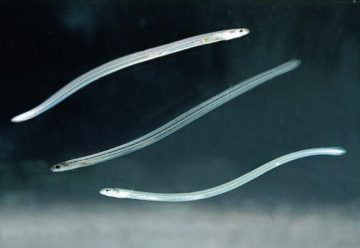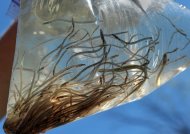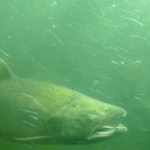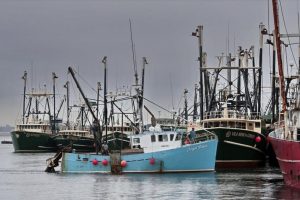Tag Archives: eel
A look at the global eel trade reveals widespread fraud – In Japan, 9.6 tons of baby eels magically appeared in 2015
 The glass eel trade is coming under international scrutiny. Already, cultured eels account for more than 99% of the world’s supplies. But the farming of these eels is totally reliant on elvers born in the wild. Although techniques to create artificial breeders to allow for the full cultivation of eels have been established, commercial production, as in the case of tuna, remains impossible. A big problem is that much of the glass eel trade essentially takes place in the dark. In Japan, the Fisheries Agency calculates the volume of the country’s eel catches by subtracting the amount of imported baby eels from that of domestic procurement. But the volume of domestic eel catches widely differs from the combined calculations of domestic catches done by prefectural governments, which issue the necessary permits. In the fishing season of 2015, for example, 18.3 tons of baby eels were procured domestically, while 3 tons were imported. The volume of eel caught domestically thus came to 15.3 tons. But data from prefectural governments, once tabulated, puts the total amount of domestic catches at 5.7 tons. The difference suggests that eel farms received 9.6 tons of glass eels from shadowy sources. Read the story here 10:36
The glass eel trade is coming under international scrutiny. Already, cultured eels account for more than 99% of the world’s supplies. But the farming of these eels is totally reliant on elvers born in the wild. Although techniques to create artificial breeders to allow for the full cultivation of eels have been established, commercial production, as in the case of tuna, remains impossible. A big problem is that much of the glass eel trade essentially takes place in the dark. In Japan, the Fisheries Agency calculates the volume of the country’s eel catches by subtracting the amount of imported baby eels from that of domestic procurement. But the volume of domestic eel catches widely differs from the combined calculations of domestic catches done by prefectural governments, which issue the necessary permits. In the fishing season of 2015, for example, 18.3 tons of baby eels were procured domestically, while 3 tons were imported. The volume of eel caught domestically thus came to 15.3 tons. But data from prefectural governments, once tabulated, puts the total amount of domestic catches at 5.7 tons. The difference suggests that eel farms received 9.6 tons of glass eels from shadowy sources. Read the story here 10:36
Is the Japanese eel industry on the slippery slope to extinction?
 “Eel has been loved in Japan for millennia,” Murakami says. “It’s crucial that we continue this ancient Japanese food culture.” The eating of freshwater eel — or unagi — is a culinary romance that has lasted more than 5,000 years. Indeed, eel bones have been found in shell mounds dating back to the Jomon Period, which lasted from around 10,000 B.C. to 200 B.C.,, Consequently, the majority of eel that makes it onto dining tables nationwide has been imported from China and Taiwan since the 1990s. According to the 2015 fisheries ministry survey, eel imports now account for approximately 60 percent of the domestic eel supply, with a large quantity of the fish being processed into kabayaki in China and shipped to Japan in a ready-to-cook form. According to another survey released this month by the fisheries ministry, the market price of baby eel — also known as elvers or glass eels — is currently ¥1,820,000 ($17,142 usd) per kilogram. By contrast, the market price of baby eel was ¥160,000 per kilogram In 2003, less than 10 percent of the existing price. Interesting article, read the rest here 17:29
“Eel has been loved in Japan for millennia,” Murakami says. “It’s crucial that we continue this ancient Japanese food culture.” The eating of freshwater eel — or unagi — is a culinary romance that has lasted more than 5,000 years. Indeed, eel bones have been found in shell mounds dating back to the Jomon Period, which lasted from around 10,000 B.C. to 200 B.C.,, Consequently, the majority of eel that makes it onto dining tables nationwide has been imported from China and Taiwan since the 1990s. According to the 2015 fisheries ministry survey, eel imports now account for approximately 60 percent of the domestic eel supply, with a large quantity of the fish being processed into kabayaki in China and shipped to Japan in a ready-to-cook form. According to another survey released this month by the fisheries ministry, the market price of baby eel — also known as elvers or glass eels — is currently ¥1,820,000 ($17,142 usd) per kilogram. By contrast, the market price of baby eel was ¥160,000 per kilogram In 2003, less than 10 percent of the existing price. Interesting article, read the rest here 17:29
American Eel Is in Danger of Extinction
 The American eel has only recently become a sought-after fish, since the 2011 tsunami in Japan wiped out eel stocks and Europe banned eel exports a year later. “We saw a big shift from the European eel to the American eel to meet demand in Asia,” says postdoctoral researcher David Jacoby of the Zoological Society of London, who was involved in the American eel assessment. “This set off alarm bells during our assessment.” Red the rest here 11:18
The American eel has only recently become a sought-after fish, since the 2011 tsunami in Japan wiped out eel stocks and Europe banned eel exports a year later. “We saw a big shift from the European eel to the American eel to meet demand in Asia,” says postdoctoral researcher David Jacoby of the Zoological Society of London, who was involved in the American eel assessment. “This set off alarm bells during our assessment.” Red the rest here 11:18
Eel fishermen meet with DFO to prevent gear conflicts
 The eel fishing season has started on Prince Edward Island and representatives from the federal Department of Fisheries and Oceans have met with fishermen to help prevent any trouble. Higher eel prices and a decline in other fishing industries have encouraged people to harvest eels. Read more here 11:39
The eel fishing season has started on Prince Edward Island and representatives from the federal Department of Fisheries and Oceans have met with fishermen to help prevent any trouble. Higher eel prices and a decline in other fishing industries have encouraged people to harvest eels. Read more here 11:39
Slippery eel slides towards disaster – Cupping a tiny, translucent eel in the palm of his hand, “This is worth about one dollar,”
 phys.org – In North America, Canada has seen a precipitous drop and introduced severe fishing restrictions, while US authorities classify the fish as “depleted.” Maine, and to a lesser extent South Carolina, are the sole US states allowed to issue commercial licenses for glass eel harvesting. And a May 21 meeting of the Atlantic States Marine Fisheries Commission could impose new restrictions. But Kate Taylor, with the fisheries commission, says so little is known about the “very mysterious” eel that US authorities have a hard time deciding what to do. continued
phys.org – In North America, Canada has seen a precipitous drop and introduced severe fishing restrictions, while US authorities classify the fish as “depleted.” Maine, and to a lesser extent South Carolina, are the sole US states allowed to issue commercial licenses for glass eel harvesting. And a May 21 meeting of the Atlantic States Marine Fisheries Commission could impose new restrictions. But Kate Taylor, with the fisheries commission, says so little is known about the “very mysterious” eel that US authorities have a hard time deciding what to do. continued
Maine fishermen resist eel harvest quotas
PressHerald.com – The American eel, at all life stages, is considered a stock for which there is limited scientific and historical data. Taylor acknowledged considerable uncertainty in the stock evaluations from which the commission is drawing information for the management ruling that will cover the Gulf of Maine and other coastal areas. The amount and quality of scientific information on the American eel is “data-poor,” she said. continued

















































